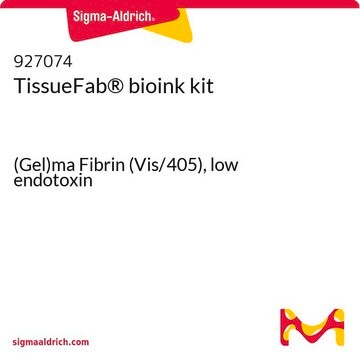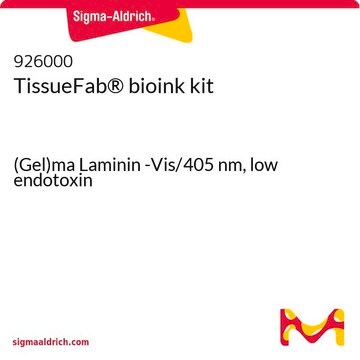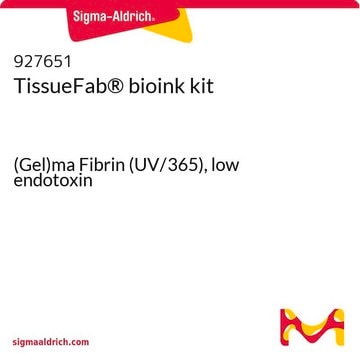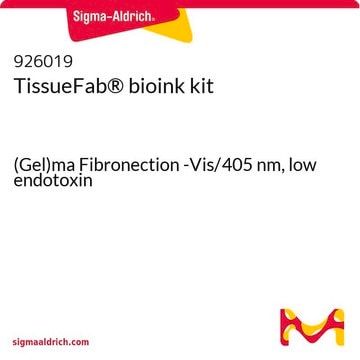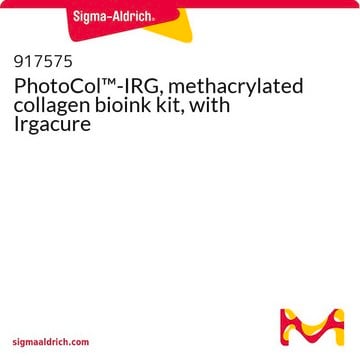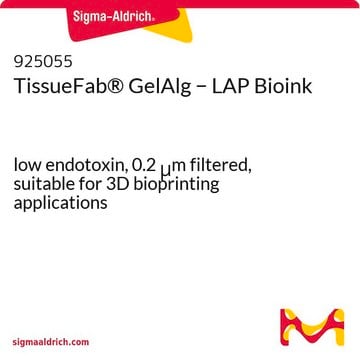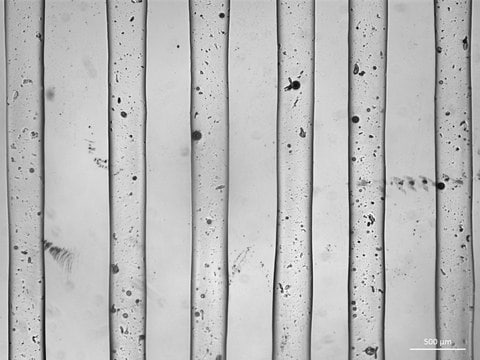927066
TissueFab® bioink kit
Fibronectin-UV/365nm
同義詞:
3D Bioprinting, Bioink, Fibronectin, GelMA, GelMA-UV fibronectin kit, Gelatin methacrylamide, Gelatin methacrylate, Gelatin methacryloyl, Low endotoxin, Suitable for 3D bioprinting applications, TissueFab
登入查看組織和合約定價
全部照片(1)
About This Item
分類程式碼代碼:
12352201
NACRES:
NA.25
推薦產品
一般說明
Gelatin methacryloyl (GelMA) is a polymerizable hydrogel material derived from natural extracellular matrix (ECM) components. Due to its low cost, abundance, and retention of natural cell binding motifs, gelatin has become a highly sought material for tissue engineering applications. Laminin is an extracellular matrix multidomain trimeric glycoprotein and is the main non-collagenous component of basal lamina that supports adhesion, proliferation and differentiation. Fibronectin is a multifunctional glycoprotein which exists as two major isoforms, one soluble and one insoluble form. The former is present in plasma, whereas the insoluble form resides in tissues and extracellular matrix (ECM) of cartilage. Fibronectin is known to contain integrin binding sequences which facilitate cell-matrix interactions. Fibronectin plays an essential role in multiple biological functions such as, angiogenesis, cell migration and differentiation and wound healing.
應用
The addition of photocrosslinkable methacrylamide functional groups in GelMA allows the synthesis of biocompatible, biodegradable, and non-immunogenic hydrogels that are stable in biologically relevant conditions and promote cell adhesion, spreading, and proliferation Gelatin methacrylate based bioinks have been used to bioprint osteogenic , chondrogenic , hepatic , adipogenic , vasculogenic , epithelial , endothelial , cardiac valve , skin , tumor and other tissues and constructs. Fibronectin has been used in tissue engineering applications for wound healing and angiogenesis , bone repair and studying mechanotransduction.
TissueFab® - GelMA Fibronectin bioink kit UV/365 features a ready-to-use bioink that is formulated for high cell viability, and printability and is designed for extrusion-based 3D bioprinting and subsequent 365 nm light crosslinking and a solution of Fibronectin to enhance the bioink. The bioink kit can be used with most extrusion-based bioprinters, are biodegradable, and are compatible with human dermal fibroblasts (HDFs) and other diverse cell types. TissueFab® - GelMA Fibronectin bioink kit UV/365 enables the precise fabrication of 3D cell models and tissue constructs for research in 3D cell biology, tissue engineering, in vitro tissue models, and regenerative medicine. Suitable for final Fibronectin concentrations up to 200 μg/ml.
特點和優勢
In addition to fast gelation, the methacrylamide functional group can also be used to control the hydrogel physical parameters such as pore size, degradation rate, and swell ratio. Temporal and spatial control of the crosslinking reaction can be obtained by adjusting the degree of functionalization and polymerization conditions, allowing for the fabrication of hydrogels with unique patterns, 3D structures, and morphologies.Low Endotoxin, low bioburden: Endotoxins have been demonstrated negatively impact cellular growth, morphology, differentiation, inflammation and protein expression. Bioburden is defined as the number of contaminated organisms found in a given amount of material. We test each lot for endotoxins as well as total bioburden (aerobic and fungal) to minimize unwanted interactions. For more information: https://www.sigmaaldrich.com/US/en/technical-documents/technical-article/microbiological-testing/pyrogen-testing/what-is-endotoxin
法律資訊
TISSUEFAB is a registered trademark of Merck KGaA, Darmstadt, Germany
儲存類別代碼
10 - Combustible liquids
分析證明 (COA)
輸入產品批次/批號來搜索 分析證明 (COA)。在產品’s標籤上找到批次和批號,寫有 ‘Lot’或‘Batch’.。
Stephanie K Seidlits et al.
Acta biomaterialia, 7(6), 2401-2409 (2011-03-29)
Biomaterials that actively promote both wound healing and angiogenesis are of critical importance for many biomedical applications, including tissue engineering. In particular, hyaluronic acid (HA) is an important player that has multiple roles throughout the angiogenic process in the body.
Marta Kisiel et al.
Biomaterials, 34(3), 704-712 (2012-10-30)
While human bone morphogenetic protein-2 (rhBMP-2) is a promising growth factor for bone regeneration, its clinical efficacy has recently shown to be below expectation. In order to improve the clinical translation of rhBMP-2, there exists strong motivation to engineer better
Alice E Stanton et al.
Acta biomaterialia, 96, 310-320 (2019-07-01)
Extracellular matrix (ECM) is comprised of different types of proteins, which change in composition and ratios during morphogenesis and disease progression. ECM proteins provide cell adhesion and impart mechanical cues to the cells. Increasing substrate stiffness has been shown to
Y Shi et al.
Biomedical materials (Bristol, England), 13(3), 035008-035008 (2018-01-09)
Three-dimensional bioprinting is an emerging technology for fabricating living 3D constructs, and it has shown great promise in tissue engineering. Bioinks are scaffold materials mixed with cells used by 3D bioprinting to form a required cell-laden structure. In this paper
B Duan et al.
Acta biomaterialia, 10(5), 1836-1846 (2013-12-18)
Tissue engineering has great potential to provide a functional de novo living valve replacement, capable of integration with host tissue and growth. Among various valve conduit fabrication techniques, three-dimensional (3-D) bioprinting enables deposition of cells and hydrogels into 3-D constructs
我們的科學家團隊在所有研究領域都有豐富的經驗,包括生命科學、材料科學、化學合成、色譜、分析等.
聯絡技術服務